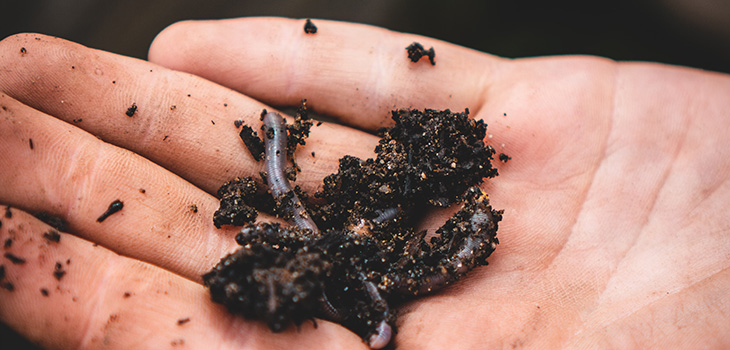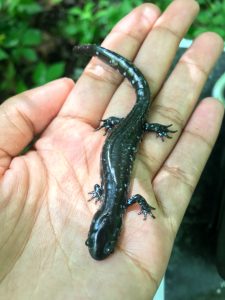 Salamanders
Salamanders
Research Students:
Laura Ullom-Minnich
Manchester University ’23
Majors: Environmental Studies, Biology
Assisted by Liam Elias
Goshen College ’22
Major: Environmental Science
WHAT IS THE RESEARCH?
“Just because you see different types of salamanders, doesn’t necessarily mean [those populations are] diverse.” Laura is studying which locations on Merry Lea’s property have genetically diverse populations of salamanders and why. This pilot study focuses on four species of salamanders: Jefferson/blue-spotted complex (hybrids of the two species), spotted, small-mouthed and Eastern red-backed salamanders. The goal is to assess population dynamics and genetic diversity of these species at specific sites. To study this, Laura recorded the number of each species that she and other researchers found at various sites and analyzed genetic diversity within and between populations.
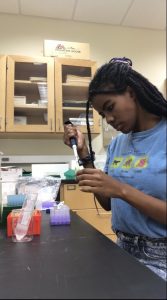 After collecting tissue samples from each salamander, Laura extracted DNA to genotype each organism: a process that looks at the genetic make-up of each salamander and compares these findings to that of others. Within the DNA are repetitive regions called microsatellites, which are useful for population genetic studies. “Microsatellites give us a footprint to the identity of the organism and gives us a reason for mutations that happen in some organisms,” said Laura. After various tests are conducted, microsatellites reveal the alleles- specific traits an individual inherited from their parents. These alleles can then be compared across individual salamanders to examine the overall genetic diversity (or lack of) within a population at each site.
After collecting tissue samples from each salamander, Laura extracted DNA to genotype each organism: a process that looks at the genetic make-up of each salamander and compares these findings to that of others. Within the DNA are repetitive regions called microsatellites, which are useful for population genetic studies. “Microsatellites give us a footprint to the identity of the organism and gives us a reason for mutations that happen in some organisms,” said Laura. After various tests are conducted, microsatellites reveal the alleles- specific traits an individual inherited from their parents. These alleles can then be compared across individual salamanders to examine the overall genetic diversity (or lack of) within a population at each site.
This information can also help pinpoint which traits are found at which sites at Merry Lea, thus informing the gene flow or diversity within and between populations. These tests can tell us whether populations are inbreeding, if certain species are hybridizing at specific sites and more.
HOW WERE SALAMANDERS CAUGHT?
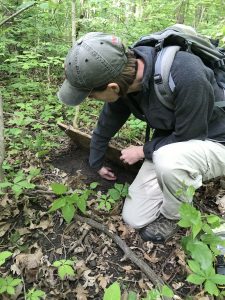 Laura, Liam and other researchers set out 140 wooden cover boards across six sites around Merry Lea. Because salamanders prefer to be under logs and other moist spots, these pieces of wood are “a sort of trapping mechanism,” explained Laura. The researchers checked under each board for salamanders twice a week, and also looked under nearby logs or objects to increase their sampling.
Laura, Liam and other researchers set out 140 wooden cover boards across six sites around Merry Lea. Because salamanders prefer to be under logs and other moist spots, these pieces of wood are “a sort of trapping mechanism,” explained Laura. The researchers checked under each board for salamanders twice a week, and also looked under nearby logs or objects to increase their sampling.
If they found a salamander, they identified the species and collected a tissue sample by snipping off either the tip of a toe or tail. This method of tissue collection is regularly employed by herpetologists and is considered ethical, as salamanders’ toes and tails often naturally fall off as a predator avoidance mechanism and grow back in a couple months. The collected tissue was preserved in tubes of ethanol, which slows the degradation of the DNA, and Laura took them to the lab to extract DNA for genotyping.
HOW WILL THIS RESEARCH INFORM OR IMPACT MERRY LEA?
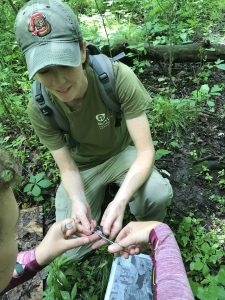 This research has larger implications than simply informing the population health of Merry Lea’s salamanders.
This research has larger implications than simply informing the population health of Merry Lea’s salamanders.
Salamanders can be used as an indicator to understand how diverse the specific sites being tested at Merry Lea are and why. Based on patterns observed in population genetics of salamanders, we can look at the larger picture to analyze how habitat conditions, such as type and age of forest and habitat fragmentation may affect biodiversity in general.
When populations are isolated and gene flow is restricted, inbreeding or hybridization can result. Laura is looking for alleles and genetic indicators that appear when two species interbreed. Knowing when and why hybridization occurs helps us understand population histories, including what could’ve impacted or forced the need for hybridization.
From a broader perspective, this type of study can hep protect future generations of salamanders and other biodiversity at Merry Lea. If a particular site is found to have a high degree of genetic diversity, a goal may be to replicate the habitat conditions of that site through restoration efforts.

